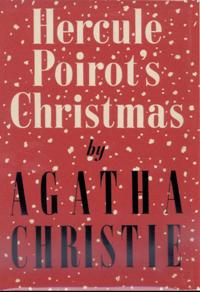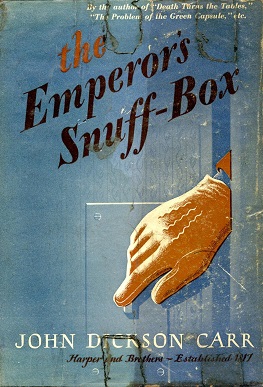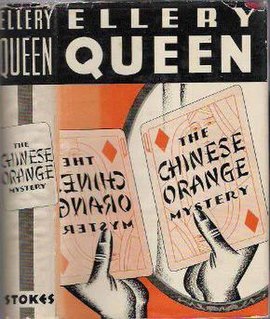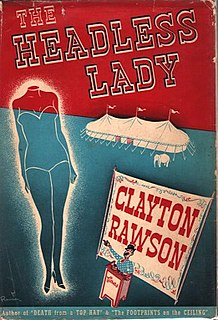Detective fiction is a subgenre of crime fiction and mystery fiction in which an investigator or a detective—either professional, amateur or retired—investigates a crime, often murder. The detective genre began around the same time as speculative fiction and other genre fiction in the mid-nineteenth century and has remained extremely popular, particularly in novels. Some of the most famous heroes of detective fiction include C. Auguste Dupin, Sherlock Holmes, and Hercule Poirot. Juvenile stories featuring The Hardy Boys, Nancy Drew, and The Boxcar Children have also remained in print for several decades.
A whodunit or whodunnit is a complex, plot-driven variety of the detective story in which the puzzle regarding who committed the crime is the main focus. The reader or viewer is provided with the clues from which the identity of the perpetrator may be deduced before the story provides the revelation itself at its climax. The investigation is usually conducted by an eccentric, amateur, or semi-professional detective. This narrative development has been seen as a form of comedy in which order is restored to a threatened social calm.

Crime fiction is a literary genre that fictionalises crimes, their detection, criminals, and their motives. It is usually distinguished from mainstream fiction and other genres such as historical fiction or science fiction, but the boundaries are indistinct. Crime fiction has multiple subgenres, including detective fiction, courtroom drama, hard-boiled fiction and legal thrillers. Most crime drama focuses on crime investigation and does not feature the court room. Suspense and mystery are key elements that are nearly ubiquitous to the genre.
The "locked-room" or "impossible crime" mystery is a subgenre of detective fiction in which a crime is committed in circumstances under which it was seemingly impossible for the perpetrator to commit the crime or evade detection in the course of getting in and out of the crime scene. The crime in question typically involves a crime scene with no indication as to how the intruder could have entered or left for example a locked room. Following other conventions of classic detective fiction, the reader is normally presented with the puzzle and all of the clues, and is encouraged to solve the mystery before the solution is revealed in a dramatic climax.
Crime is a typically 19th-, 20th- and 21st-century genre, dominated by British and American writers. This article explores its historical development as a genre.

The Mystery of the Yellow Room is a mystery novel written by French author Gaston Leroux. One of the first locked-room mystery novels, it was first published serially in France in the periodical L'Illustration from September 1907 to November 1907, then in its own right in 1908.

Dr Gideon Fell is a fictional character created by John Dickson Carr. He is the protagonist of 23 mystery novels from 1933 through 1967, as well as a few short stories. Carr was an American who lived most of his adult life in England; Dr. Fell is an Englishman who lives in the London suburbs.

Hercule Poirot's Christmas is a work of detective fiction by Agatha Christie and first published in the UK by the Collins Crime Club on 19 December 1938. It retailed at seven shillings and sixpence (7/6).
An inverted detective story, also known as a "howcatchem", is a murder mystery fiction structure in which the commission of the crime is shown or described at the beginning, usually including the identity of the perpetrator. The story then describes the detective's attempt to solve the mystery. There may also be subsidiary puzzles, such as why the crime was committed, and they are explained or resolved during the story. This format is the opposite of the more typical "whodunit", where all of the details of the perpetrator of the crime are not revealed until the story's climax.

The Emperor's Snuff-Box is a non-series mystery novel (1942) by mystery novelist John Dickson Carr. The detective is psychologist Dr. Dermot Kinross.

The Dutch Shoe Mystery is a novel which was written in 1931 by Ellery Queen. It is the third of the Ellery Queen mysteries.

The Chinese Orange Mystery is a novel that was written in 1934 by Ellery Queen. It is the eighth of the Ellery Queen mysteries.
Joseph Commings was an American writer of locked room mysteries. He wrote a series of soft-core sex novels, but is best known for his locked-room mystery/impossible crime short stories featuring Senator Brooks U. Banner."
The Footprints on the Ceiling (1939) is a locked-room mystery novel written by Clayton Rawson.

The Headless Lady (1940) is a whodunnit mystery novel written by Clayton Rawson. A character in the novel, a detective story writer named Stuart Towne, has the same name as a pen name of Rawson. This is the third of four mysteries featuring The Great Merlini, a stage magician and Rawson's favorite protagonist.

No Coffin for the Corpse (1942) is a whodunnit mystery novel written by Clayton Rawson.

Miracles for Sale is a 1939 American mystery film directed by Tod Browning, and starring Robert Young and Florence Rice. It was Browning's final film as a director.











